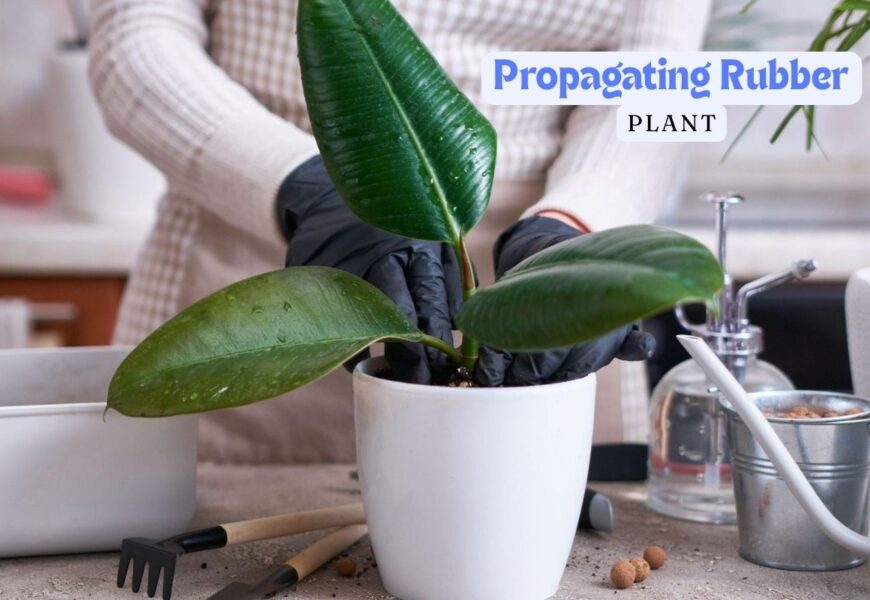Introduction
Propagating rubber plants is a rewarding way to expand your indoor greenery and share plants with friends or family. With the right techniques, even beginners can successfully grow new plants from cuttings or air layering. Understanding the growth habits of rubber plants ensures healthier, stronger offspring. This guide will walk you through proven methods to propagate your plant efficiently. By following these steps, you can enjoy thriving new rubber plants in your home
Warning and Precautions
Before starting propagation, it’s important to take safety and plant health precautions. Rubber plant sap can be irritating to the skin and eyes, so wearing gloves and protective clothing is recommended. Avoid using damaged or diseased stems, as they may fail to root or spread infections. Ensure all tools are clean and sterilized to prevent bacterial or fungal growth. Taking these precautions increases the chances of successful propagation and keeps both you and your plant safe.
Materials and Tools Needed
Successful rubber plant propagation requires a few essential tools and materials. You will need a sharp, clean knife or pruning shears to make precise cuts. Rooting hormone can help encourage faster root development in cuttings. Additionally, prepare pots, well-draining soil, or water containers depending on your chosen method. Having all materials ready ensures a smooth propagation process and improves the success rate of new plants.
Choosing the Right Time to Propagate
Timing plays a crucial role in the success of rubber plant propagation. The best period is during the plant’s active growing season, typically in spring or early summer, when new growth is vigorous. Avoid propagating during cold or dormant months, as cuttings may struggle to root. Selecting healthy, mature stems ensures stronger and faster development. Proper timing increases the likelihood of strong, thriving new plants.
Selecting the Stem or Leaf for Propagation
Choosing the right part of the plant is essential for successful propagation. Select healthy, mature stems with at least a few leaves and no signs of disease or damage. For stem cuttings, pick a branch that is firm but not too woody, as it roots more easily. Leaf cuttings can also be used, but they require careful handling to avoid bruising. Proper selection ensures faster rooting and a higher success rate for new plants.
Preparing the Cutting
Once you’ve selected a healthy stem or leaf, preparation is key to encouraging rooting. Trim the cutting just below a node, removing any damaged or excess leaves. If desired, dip the cut end in the rooting hormone to stimulate root growth. Make sure the cutting is clean and free from sap buildup to prevent infection. Properly prepared cuttings have a higher chance of developing strong, healthy roots.
Propagation Methods Overview
Rubber plants can be propagated using several effective methods, each suited for different situations. Stem cuttings, either in soil or water, are the most common and beginner-friendly approach. Leaf cuttings are also possible but require more patience and care. Air layering allows propagation from larger, mature stems and often produces faster results. Understanding these methods helps you choose the best technique for your plant and available resources.
Stem Cuttings in Soil
Propagating rubber plants using stem cuttings in soil is a straightforward and reliable method. Start by planting the prepared cutting in a pot filled with well-draining soil. Water lightly to keep the soil moist but avoid overwatering, which can cause rot. Place the pot in a warm, bright location with indirect sunlight to encourage root growth. With proper care, roots typically develop within a few weeks, resulting in a healthy new plant.
Stem Cuttings in Water
Rooting rubber plant cuttings in water is an easy way to monitor progress and ensure successful growth. Place the prepared cutting in a container of clean water, making sure the cut end is fully submerged. Change the water every few days to prevent bacterial buildup and keep it fresh. Position the container in a bright area with indirect sunlight to promote root development. Once roots are a few inches long, the cutting can be transferred to soil for continued growth.
Air Layering Technique
Air layering is a propagation method that encourages roots to grow on a mature stem before cutting it from the parent plant. Begin by selecting a healthy stem and making a small wound to expose the inner tissue. Wrap the wounded area with moist sphagnum moss and cover it with plastic to retain humidity. Check regularly to ensure the moss stays damp and monitor for root development. Once sufficient roots have formed, the stem can be cut and potted as a new independent plant.
Caring for Cuttings During Rooting
Proper care during rooting is essential for healthy rubber plant development. Keep cuttings in a warm, bright spot with indirect sunlight to prevent stress or burning. Maintain consistent moisture in the soil or water, avoiding both drying out and overwatering. Monitor for signs of mold, rot, or pests, and remove any affected leaves immediately. With attentive care, cuttings will develop strong roots and be ready for transplanting.
Post-Propagation Care
After rooting, transplanted rubber plant cuttings require gentle post-propagation care. Use well-draining soil and a slightly larger pot to give roots room to grow. Water moderately, allowing the top layer of soil to dry slightly between watering. Keep the plant in a bright location with indirect sunlight to encourage steady growth. Regular monitoring and gradual acclimation ensure the new plant establishes successfully and thrives long-term.
Common Issues During Propagation
During propagation, rubber plant cuttings may encounter problems such as leaf drop, root rot, or slow growth. Overwatering or poor drainage is a frequent cause of root rot, while insufficient light can stunt development. Pests like aphids or spider mites may also affect young cuttings if not monitored. Regular inspection and proper care can prevent most issues. Addressing problems early increases the likelihood of successful propagation.
Propagating Rubber Plant Varieties
Different rubber plant varieties, such as Ficus elastica and Baby Rubber Plant (Peperomia obtusifolia), may require slight adjustments in propagation techniques. Ficus elastica cuttings root well in both soil and water, while Baby Rubber Plants often respond better to stem or leaf cuttings in soil. Understanding each variety’s growth habits ensures higher success rates. Choose healthy, mature stems appropriate for the specific type. Tailoring methods to the variety promotes faster rooting and stronger new plants.
Pruning Tips to Support Propagation
Pruning your rubber plant can improve overall health and encourage successful propagation. Remove dead, damaged, or overcrowded branches to redirect energy toward new growth. Trim healthy stems carefully to create cuttings without stressing the parent plant. Regular pruning also maintains a manageable size and shape, making future propagation easier. By combining pruning with proper propagation techniques, you ensure both the parent and new plants thrive.
Benefits of Propagating Rubber Plants
Propagating rubber plants offers multiple advantages that make the effort worthwhile. It allows gardeners to expand their indoor greenery without buying new plants. Sharing propagated plants can brighten homes or serve as thoughtful gifts. Propagation also supports the parent plant’s health by encouraging new growth. Key benefits include:
- Cost-effective: Grow multiple plants from one parent.
- Plant health: Pruning and propagation stimulate stronger growth.
- Educational experience: Learn hands-on plant care techniques.
- Sustainability: Reduce the need to purchase new plants.
Expert Tips
Successfully propagating rubber plants requires patience, proper technique, and attentive care. By selecting healthy cuttings, choosing the right propagation method, and maintaining optimal conditions, you can grow strong, thriving new plants. Regular monitoring and timely adjustments prevent common issues like rot or leaf drop. Expert tips, such as using rooting hormone and pruning strategically, further increase success rates. With these proven methods, anyone can enjoy a flourishing collection of rubber plants at home.
Conclusion
Propagating rubber plants is a simple yet rewarding way to expand your indoor garden and create new healthy plants. By following proper techniques, from selecting the right cuttings to choosing the ideal propagation method, you can ensure strong root development and vibrant growth. Regular care, attention to moisture, light, and post-propagation maintenance will help your new plants thrive. Understanding common issues and applying preventive measures increases your chances of success. With patience and consistency, anyone can enjoy flourishing rubber plants at home.















